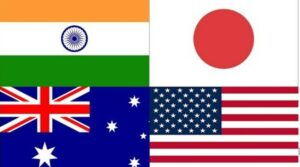India and QUAD Grouping: Article Analysis
India and QUAD Grouping: Article Analysis

Mains Topic:GS-2
- International Relations
Introduction:
- The Quadrilateral Security Dialogue (QSD), better known as the ‘Quad’, started as a strategic dialogue in 2007. The dialogue members included India, the US, Australia and Japan. It was established to check the growth of Chinese power in what was still referred to as ‘Asia-Pacific’, and which has since become ‘Indo-Pacific’.
- The Quad had its real genesis in the response to the 2004-2005 Asian Tsunami when India showed prowess in spearheading the relief and rescue effort in South East Asia.
Objective of The Grouping:
- However, the principal aim of the Quad was strategic, with a quest to manage the consequences for the regional balance of power in the Indo-Pacific due to the scale and scope of China’s rise.
- Beijing, meanwhile, raised objections and sought clarifications about what the intentions were behind the Quad.
- The Australians clarified under the Liberal-National Coalition government that they were going to endorse the Quadrilateral as a cooperative undertaking on peacekeeping and economic issues and not a strategic or military grouping. India, too, sought to dispel doubts by telling then Chinese president Hu Jintao that the Quad was more about sharing democratic experiences than a security arrangement directed at China.
The cold Phase and the revival:
- In November 2007, with the Australian Labour Party assuming power under Kevin Rudd, Canberra backed out of the Quad altogether.
- However, after a full decade in cold storage, the ‘Quad’ came full circle from starting hesitantly and then being abandoned to its eventual revival in November 2017.
- Again, the principal motivating factor behind the Quad was China as the primary challenge to Asian geostrategic security. In the period 2007-2017, much had changed, with Beijing flexing its muscle through its island-building spree in the South China Sea (SCS), its assertiveness against Taiwan, its claims against Japan over the Senkaku/Diaoyu, and its attempts to ratchet up tension on its disputed land frontiers with India.
- Cumulatively, these factors explain the resuscitation of the Quad. In November 2017, India, the Quad countries held “consultations on issues of common interest in the Indo-Pacific” in Manila.
New Strategies:
- This development came in the backdrop of incremental moves by all four members engaging each other bilaterally and trilaterally. Since the collapse of the initial Quad arrangement, an India-US bilateral, a bilateral between India and Australia and another bilateral between Japan and India have been held. Finally, there are the trilaterals, comprising India-US-Japan and India-Australia-Japan. Such trilateral and bilateral engagements have been pivotal in the years during which the Quad never officially met.
Future of the Grouping:
- Nevertheless, doubts still remain about the Quad’s fate. From New Delhi’s standpoint, it has not only concerns about Beijing’s reaction if the arrangement were to assume a concerted effort to contain China, but more importantly whether Australia in particular could sustain the effort due to close Sino-Australian relation As a result, Delhi sees Canberra as the weakest link in the Quad.
- Within Australia, there is a vibrant debate on its future foreign policy trajectory, and there is considerable anxiety over the consequences of the Quad on Sino-Australian relations.
- The other three Quad members, India, Japan, and the US are better positioned to consolidate their engagement and, if need be, build a balancing coalition against China.
- However, the Quad has expanded its focus to include a rule-based international order. If the four-member grouping can prevent itself from collapsing as it did in 2007, because of tactical considerations India, Japan and Australia can move towards cooperation that is more robust. Beyond maritime cooperation and more generally military-to-military cooperation, the Quad states will have to identify areas of cooperation such as connectivity, capacity building and cyber security.
Recent Affairs:
- Most recently, the Quad countries met on the sidelines of the 13th East Asia Summit in Singapore, stressing upon the centrality of the ASEAN for regional security and committing themselves to partner with multiple countries and forums to promote rule based, open, free and inclusive Indo-Pacific.
- This was in line with Prime Minister Narendra Modi’s Shangri La Dialogue speech earlier this year where he emphasised “free, open and transparent Indo-Pacific, grounded in respect for international maritime laws,” but rebuffed suggestions that the Quad should be viewed as an exclusive club.
- The Quad remains a work in progress and its members are still in the process of defining its priorities. But there is no denying the fact that structural changes in the Indo-Pacific over the last few years, thanks to China’s rise and international behaviour, have given this arrangement a new sense of urgency.
Source:Deccan Herald











